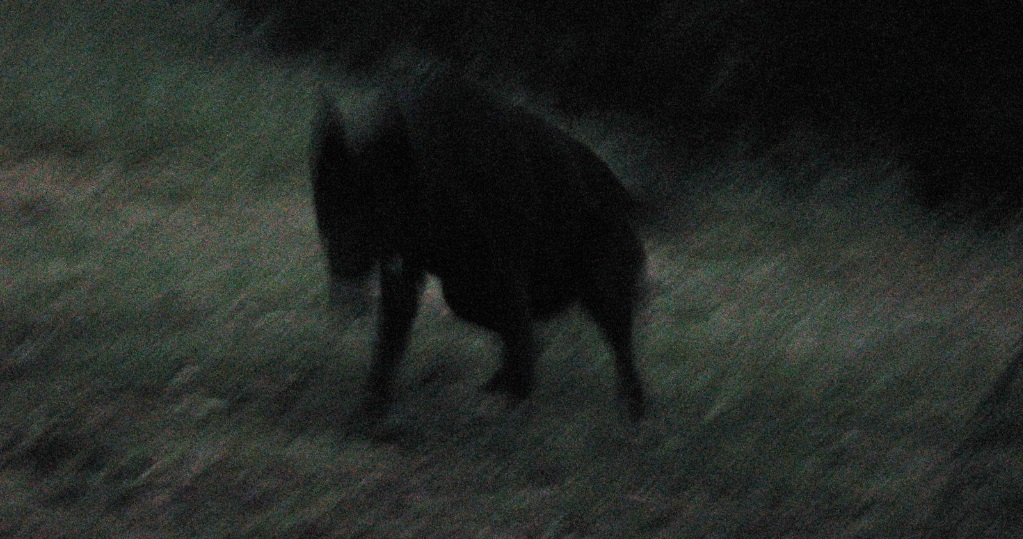Skuh
After the fall of monarchy, the revolutionaries arrived at the castle kennels to find them empty. On hearing this, the commandant ordered the castle grounds immediately evacuated, and the parks barricaded, for the lineage of the great hounds was as long and bloody as their masters'.A History of Nations, vol..4: Bjeria
History
Due to changes in behaviour since the fall of Bjeria, skuh in this article will be differentiated as 'domesticated' (pre-war) and 'feral' (mid-war), and 'wild' (post-war).Pre-war
Skuh were originally bred to hunt midwinter auroch, with kennelmasters selecting for strength and intelligence. The resulting animal was a massively powerful pack hunter, fully capable of bringing down anything shy of a juvenile auroch, though people who remember the hounds from before the revolution describe them as being 'creepy' and feeling watched or 'observed' whenever they were around the animals.The royal hunt featured three packs: one of younger hounds, who ran with the main hunt and two comprised of older, more experienced animals who were operated autonomously. The latter two groups would harry the herd, separating a noble target for the High Hunts, or an old and sick animal for low hunts. Persistent rumours that skuh were used to hunt sapient beings for sport date back to the founding of the state and were common, especially outside of Bjeria.
Post-war
During the war, the hunts were abandoned - auroch were too dangerous of a target to risk during a time of national crisis - and neither the kennels nor the herds were maintained, making it difficult to estimate the population.During the revolution, the hounds escaped from the locked kennels and into the parks. After the Magisterium annexed Bjeria, they attempted to wipe out both the skuh and the auroch, but only succeeded in driving both out of the parks and across the eastern continent.
Intelligence
Domesticated skuh were considered among the most intelligent breeds of dog, and this appears to have become an effective means of survival for their descendents.Tool use
Domesticated skuh were known to learn how to operate simple tools from observing humans and animals around them. This information was passed to their pack mates and spread rapidly. They were observed unlatching doors to gain access to barns and store rooms, necessitating padlocks on kennel stores, and setting a wildfire to drive a herd into a more vulnerable position during a summer hunt.Magisterium reports include accounts of feral skuh being observed remotely triggering or - in one case - repurposing wolf-traps set to catch them. Locals to the parks reported skuh entering properties to sleep during the Deep Winter of 1919.
Tool use in wild skuh is undocumented, due to lack of reliable sightings, but consdered likely.
Mimicry
Historically, skuh used mimicry to mask their approach prior to an attack, being able to imitate a number of birds, and feral skuh made frequent use of species-appropriate vocalisations when hunting. In light of this fact, it is reasonable to expect that mimicry continues to play a part in wild skuh's hunting techniques as they shift from aurochs to more available prey.Skuh attacks on livestock housed near farmhouse are characterised by reports of singing or human vocalisations - often in the voice of one of the occupants - prior to the assault.
In addition, individuals in isolated regions with known skuh populations report hearing singing at night, sometimes recognising a voice in the chorus as their own, or that of someone known to be deceased. The singing is described as "profoundly unsettling" and "unaearthly", but does not appear to be part of normal hunting behaviour.
Aggression
Conflict with spient species
Attacks on sapients were unheard of prior to the winter of 1921, when hunger and cold drove packs into closer proximity to settlements. Since then, fatal attacks on travellers have become more frequent, although they rarely feature children, or pregnant or nursing adults - apparently applying a similar herd-culling behaviour to humanity as they did to the auroch. Non-fatal attacks may be assumed to be the result of therianthropic infection and should be treated accordingly.Conflict with other animals
The interactions between skuh and wolves is poorly understood, but it is so frequently noted that the behaviour of wolves changes in areas with an emerging skuh populations that the following behaviour pattern may be indicative of at least one pack moving int othe region:- Wolves driven into closer proximity to human settlements.
- A sudden decline in observed wolf numbers.
- Discovery of wolf carcasses with therianthrophic infection.
Additional Information
Social Structure
Family pack structure - two breeding adults and non-breeding offspring.
Symbiotic and Parasitic organisms
Asymptomatic carrier of the therianthropy parasite
Scientific Name
hrort tird atærmæ
Lifespan
13-20 years
Average Height
85 - 110cm
Average Weight
110-175 kg
Average Length
110-125 cm
Average Physique
Long-legged, with heavy jaws. Little sexual dimorphism.
Body Tint, Colouring and Marking
Black fur over black skin. Black eyes with red eyeshine.
Remove these ads. Join the Worldbuilders Guild



Comments